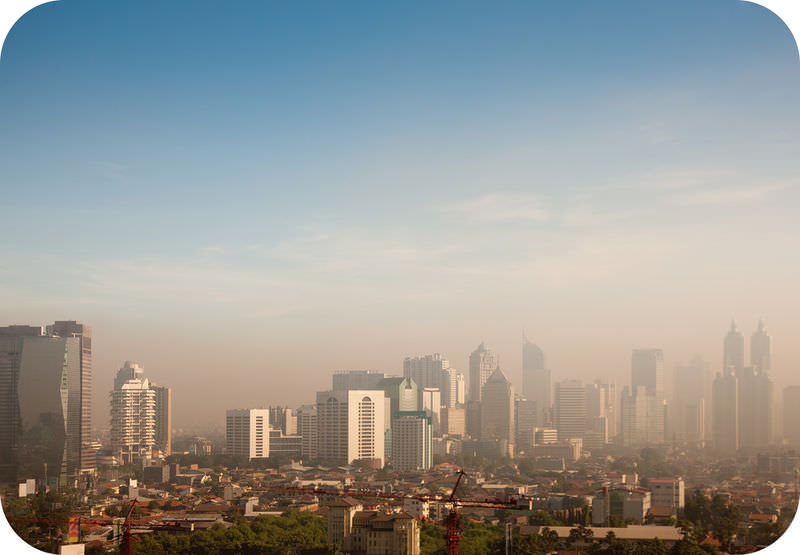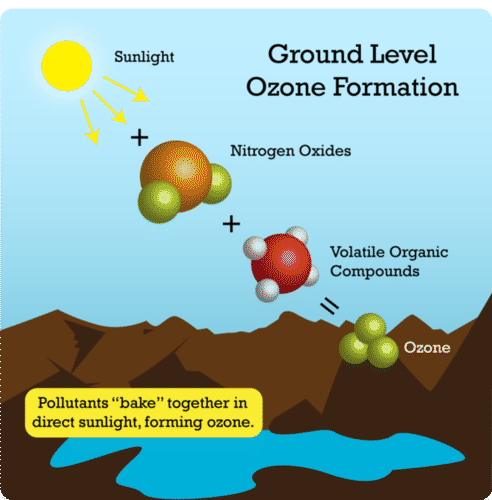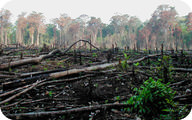空气污染的种类
章节大纲
-
Lesson
::经验教训What is a pollution advisory?
::什么是污染咨询?Urban areas in sunny locations have pollution advisories. This happens when ozone levels get high. On these days, you should stay indoors or exercise early or late in the day . Drive less and avoid filling your tank.
::阳光明媚的城市地区有污染警告,当臭氧含量升高时,就会发生这种情况。这些天,你应该留在室内,或者白天早晚锻炼,少开车,避免填满水箱。Air Pollutants
::空气污染物There are two main types of air pollutants: primary and secondary. Most air pollutants come from burning fossil fuels . Some come from burning forests. Some are due to the evaporation of chemicals.
::空气污染物主要有两种类型:一级和二级,大多数空气污染物来自燃烧化石燃料,有些来自燃烧森林,有些是由于化学品蒸发。Types of Air Pollutants
::各类空气污染物的类型There are two basic types of pollutants in the air. They are known as primary pollutants and secondary pollutants . Primary pollutants enter the air directly. Some are released by natural processes, like ash from . Most are released by human activities.
::空气中有两种基本类型的污染物,称为主要污染物和次要污染物,主要污染物直接进入空气,有些是自然过程释放出来的,例如灰尘,大部分是人类活动释放出来的。- Carbon oxides are released when fossil fuels burn.
::化石燃料燃烧时释放出氧化碳。
- Nitrogen oxides form when nitrogen and oxygen combine at high temperatures. This occurs in hot exhausts from vehicles, factories, and power plants.
::当氮和氧在高温时形成氮氧化物,这发生在汽车、工厂和发电厂的热排气管中。
- Sulfur oxides are produced when sulfur and oxygen combine. This happens when coal that contains sulfur burns.
::硫氧化物在硫和氧合而为一时产生,在含硫的煤炭燃烧时产生。
- Toxic heavy metals include mercury and lead. Mercury comes from smokestacks. Both metals have industrial uses.
::有毒重金属包括汞和铅,汞来自烟囱,两种金属都有工业用途。
- Volatile organic compounds (VOCs) are carbon compounds, such as methane. VOCs are released by many human activities. Raising livestock, for example, produces a lot of methane.
::挥发性有机化合物(VOCs)是碳化合物,如甲烷,许多人类活动释放了挥发性有机化合物。
- Particulates are solid particles. These particles may be ash, dust, or even animal wastes. Many are released when fossil fuels burn.
::片段是固态颗粒。 这些颗粒可能是灰尘、尘埃,甚至动物废物。 许多颗粒是在化石燃料燃烧时释放出来的。
Secondary pollutants form from primary pollutants. Many occur as part of photochemical smog . This type of smog is seen as a brown haze in the air. Photochemical smog forms when certain pollutants have a chemical reaction in the presence of sunlight. Photochemical smog consists mainly of ozone (O 3 ). Ozone near the ground is a pollutant ( Figure ). This ozone is harmful to humans and other living things. However, ozone in the protects Earth from the Sun's harmful ultraviolet radiation .
::从原始污染物中形成的次级污染物。许多是光化烟雾的一部分。这种烟雾被视为空气中的褐色烟雾。当某些污染物在阳光下发生化学反应时,光化烟雾的形式是光化学的。光化学烟雾主要由臭氧(O3)组成。地面附近的臭氧是一种污染物(图)。这种臭氧对人类和其他生物有害。然而,保护地球的臭氧免受太阳的有害紫外线辐射。Ozone forms near the ground as a secondary pollutant. Sources of Air Pollutants
::空气污染物的来源Most pollutants enter the air when fossil fuels burn. Some are released when forests burn. Others evaporate into the air.
::大多数污染物在矿物燃料燃烧时进入空气,有些在森林燃烧时释放,另一些在空气中蒸发。Burning Fossil Fuels
::燃烧化石燃料Burning fossil fuels releases many pollutants into the air. These pollutants include carbon monoxide, carbon dioxide, nitrogen dioxide, and sulfur dioxide.
::燃烧化石燃料将许多污染物释放到空气中,这些污染物包括一氧化碳、二氧化碳、二氧化氮和二氧化硫。- Motor vehicles account for almost half of fossil fuel use.
::机动车辆几乎占矿物燃料使用量的一半。
- Power plants and factories account for more than a quarter of fossil fuel use ( Figure ).
::发电厂和工厂占矿物燃料使用量的四分之一以上(图)。
- Homes and other buildings burn fossil fuels.
::房屋和其他建筑燃烧化石燃料。
Smoke stacks release a lot of pollutants into the air. Burning Forests
::燃烧森林Millions of acres of forest have been cut and burned to make way for farming ( Figure ). Burning trees produces most of the same pollutants as burning fossil fuels.
::数百万英亩的森林被砍伐和焚烧,以便耕种(图......),燃烧的树木产生的污染物与燃烧化石燃料的污染物大多相同。Cutting and burning trees to clear land for farming is called slash-and-burn agriculture. How does this affect the atmosphere? Evaporation of VOCs
::VOCs蒸发VOCs enter the air by evaporation. VOCs are found in many products, like paints and petroleum products. Methane is a VOC that evaporates from livestock waste and landfills.
::挥发性有机物通过蒸发进入空气中,许多产品中都发现了挥发性有机物,如油漆和石油产品,甲烷是一种挥发性有机物,从牲畜废物和垃圾填埋场中蒸发。Summary
::摘要- There are many types of primary pollutants, including carbon oxides, nitrogen oxides, sulfur oxides, particulates, lead, and volatile organic compounds.
::存在多种类型的主要污染物,包括氧化碳、氧化氮、氧化硫、微粒、铅和挥发性有机化合物。
- Secondary pollutants form from chemical reactions that occur when pollution is exposed to sunlight.
::二次污染物来自污染暴露在阳光下的化学反应。
- Most pollutants enter the atmosphere from fossil fuel burning. Burning forests and evaporation of some chemicals account for most of the rest.
::大多数污染物通过矿物燃料燃烧进入大气层,其余大部分是燃烧森林和蒸发某些化学品。
Review
::回顾- How are primary and secondary pollutants different?
::初级和二级污染物有何不同?
- Why do fossil fuels account for so much air pollution?
::为什么化石燃料造成如此之多的空气污染?
- What is ozone? Where is it harmful? Where is it beneficial?
::什么是臭氧?它在哪里有害?它在哪里有益?它在哪里有益?
- Carbon oxides are released when fossil fuels burn.



